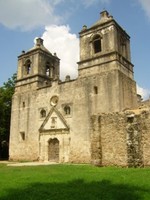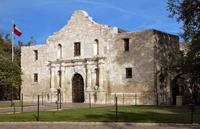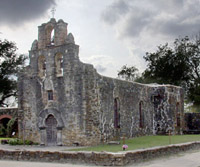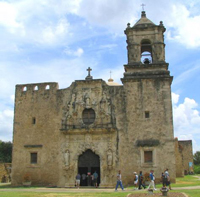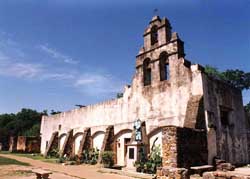Costa Impianti 3805098115 Arezzo
Menu principale:
Info Mission
America Texas > Missions San Antonio
La battaglia di Concepción fu combattuta il 28 ottobre 1835 tra le truppe messicane sotto il colonnello Domingo Ugartechea e gli insorgenti del Texas comandati da James Bowie e James Fannin. La battaglia durata trenta minuti, che lo storico J.R. Edmondson descrive come "il primo grande scontro della rivoluzione texana", si verificò sul territorio di Mission Concepcion, a circa 2 miglia (3,2 km) da San Antonio.
La Battaglia di Alamo fu una battaglia tra le forze messicane e texane durante la rivoluzione texana, la battaglia ebbe luogo nella vecchia missione spagnola di El Alamo vicino San Antonio e si svolse tra il febbraio e il marzo del 1836.
L'assedio terminò il 6 marzo con la presa della missione e la morte di tutti i
difensori texani.
Mission San Francisco de la Espada founded in 1690 as San Francisco de los Tejas near present-day Weches, Texas, this was the first mission in Texas. In 1731, the mission transferred to the San Antonio River area and renamed Mission San Francisco de la Espada. A friary was built in 1745, and the church was completed in 1756.
Following government policy, Franciscan missionaries sought to make life within mission communities closely resemble that of Spanish villages and Spanish culture. In order to become Spanish citizens and productive inhabitants, Native Americans learned vocational skills. As plows, farm implements, and gear for horses, oxen, and mules fell into disrepair, blacksmithing skills soon became indispensable. Weaving skills were needed to help clothe the inhabitants. As buildings became more elaborate, mission occupants learned masonry and carpentry skills under the direction of craftsmen contracted by the missionaries.
Mission San José y San Miguel de Aguayo known as the "Queen of the Missions", this is the largest of the missions and was almost fully restored to its original design in the 1930s by the WPA (Works Projects Administration). Spanish missions were not churches, but communities, with the church the focus. Mission San José shows the visitor how all the missions might have looked over 250 years ago.
Mission San Juan Capistrano originally founded in 1716 in eastern Texas, Mission San Juan was transferred in 1731 to its present location. In 1756, the stone church, a friary, and a granary were completed. A larger church was begun, but was abandoned when half complete, the result of population decline.
San Juan was a self-sustaining community. Within the compound, Indian artisans produced iron tools, cloth, and prepared hides. Orchards and gardens outside the walls provided melons, pumpkins, grapes, and peppers. Beyond the mission complex Indian farmers cultivated maize (corn), beans, squash, sweet potatoes, and sugar cane in irrigated fields. Over 20 miles southeast of Mission San Juan was Rancho de Pataguilla, which, in 1762, reported 3,500 sheep and nearly as many cattle.
These products helped support not only the San Antonio missions, but also the local settlements and presidial garrisons in the area. By the mid 1700s, San Juan, with its rich farm and pasturelands, was a regional supplier of agricultural produce. With its surplus, San Juan established a trade network stretching east to Louisiana and south to Coahuila, Mexico. This thriving economy helped the mission to survive epidemics and Indian attacks in its final years.
